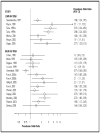Bacterial vaginosis and HIV acquisition: a meta-analysis of published studies
- PMID: 18614873
- PMCID: PMC2788489
- DOI: 10.1097/QAD.0b013e3283021a37
Bacterial vaginosis and HIV acquisition: a meta-analysis of published studies
Abstract
Objectives: To assess and summarize the published literature on the extent to which bacterial vaginosis may increase the risk of HIV acquisition.
Design: Meta-analysis of published studies.
Methods: Medline and other electronic databases were systematically searched for eligible publications. The association between bacterial vaginosis and incident HIV was separately analyzed from that between bacterial vaginosis and prevalent HIV. The latter was further analyzed, stratified by bacterial vaginosis diagnostic method, HIV risk profile of the study population, and whether or not adjusted estimates were presented.
Results: Twenty-three eligible publications were identified, including a total of 30,739 women. Bacterial vaginosis was associated with an increased risk of HIV acquisition in HIV-incidence studies (relative risk = 1.6, 95% confidence interval: 1.2, 2.1). All but one of 21 HIV-prevalence studies reported estimates above the null. The latter results were heterogeneous and showed some evidence of funnel plot asymmetry, precluding the estimation of a single summary measure. The association between bacterial vaginosis and HIV in prevalence studies appeared stronger for women without high-risk sexual behavior.
Conclusion: Bacterial vaginosis was consistently associated with an increased risk of HIV infection. High bacterial vaginosis prevalence may result in a high number of HIV infections being attributable to bacterial vaginosis. More prospective studies are needed to accurately evaluate the role of bacterial vaginosis in HIV acquisition in low-risk versus high-risk women. Furthermore, randomized clinical trials may be worth considering to determine the effect of bacterial vaginosis control measures on HIV acquisition.
Figures



Similar articles
-
Low prevalence of bacterial vaginosis in Kenyan adolescent girls and rapid incidence after first sex.Am J Obstet Gynecol. 2023 Sep;229(3):282.e1-282.e11. doi: 10.1016/j.ajog.2023.06.044. Epub 2023 Jun 28. Am J Obstet Gynecol. 2023. PMID: 37391005 Free PMC article.
-
HIV-1 infection associated with abnormal vaginal flora morphology and bacterial vaginosis.Lancet. 1997 Aug 23;350(9077):546-50. doi: 10.1016/s0140-6736(97)01063-5. Lancet. 1997. PMID: 9284776
-
Longitudinal analysis of bacterial vaginosis: findings from the HIV epidemiology research study.Obstet Gynecol. 2001 Oct;98(4):656-63. doi: 10.1016/s0029-7844(01)01525-3. Obstet Gynecol. 2001. PMID: 11576584
-
Risks associated with bacterial vaginosis in infertility patients: a systematic review and meta-analysis.Hum Reprod. 2013 Jul;28(7):1809-15. doi: 10.1093/humrep/det096. Epub 2013 Mar 29. Hum Reprod. 2013. PMID: 23543384 Review.
-
Intravaginal practices, bacterial vaginosis, and HIV infection in women: individual participant data meta-analysis.PLoS Med. 2011 Feb 15;8(2):e1000416. doi: 10.1371/journal.pmed.1000416. PLoS Med. 2011. PMID: 21358808 Free PMC article. Review.
Cited by
-
Non-specific microbicide product development: then and now.Curr HIV Res. 2012 Jan 1;10(1):9-18. doi: 10.2174/157016212799304625. Curr HIV Res. 2012. PMID: 22264041 Free PMC article. Review.
-
Mechanisms and modifications of naturally occurring host defense peptides for anti-HIV microbicide development.Curr HIV Res. 2012 Jan 1;10(1):61-72. doi: 10.2174/157016212799304580. Curr HIV Res. 2012. PMID: 22264047 Free PMC article. Review.
-
The Microbiological Context of HIV Resistance: Vaginal Microbiota and Mucosal Inflammation at the Viral Point of Entry.Int J Inflam. 2012;2012:131243. doi: 10.1155/2012/131243. Epub 2012 Mar 14. Int J Inflam. 2012. PMID: 22506135 Free PMC article.
-
Microbial signatures and continuum in endometrial cancer and benign patients.Microbiome. 2024 Jul 1;12(1):118. doi: 10.1186/s40168-024-01821-0. Microbiome. 2024. PMID: 38951935 Free PMC article.
-
Increased vaginal pH in Ugandan women: what does it indicate?Eur J Clin Microbiol Infect Dis. 2016 Aug;35(8):1297-303. doi: 10.1007/s10096-016-2664-2. Epub 2016 May 14. Eur J Clin Microbiol Infect Dis. 2016. PMID: 27180245
References
-
- Sobel JD. Vaginitis. N Engl J Med. 1997;337:1896–1903. - PubMed
-
- Marrazzo J. Bacterial Vaginosis. Current Treatment Options in Infectious Diseases. 2003;5:63–68.
-
- Hillier S, Holmes K. Bacterial vaginosis. In: Holmes PSK, Mardh P, et al., editors. Sexually Transmitted Diseases. 3. McGrawHill; NewYork: 1999. pp. 563–586.
-
- McDonald H, Brocklehurst P, Parsons J, Vigneswaran R. Antibiotics for treating bacterial vaginosis in pregnancy. Cochrane Database Syst Rev. 2003:CD000262. - PubMed
-
- Hillier S, Wiesenfeld H, Murray P, Busse B, Marrazzo J. Microbicides 2004. London: 2004. Vaginal fluid SLPI is related to vaginal flora and hormonal contraception.
Publication types
MeSH terms
Grants and funding
LinkOut - more resources
Full Text Sources
Other Literature Sources
Medical

